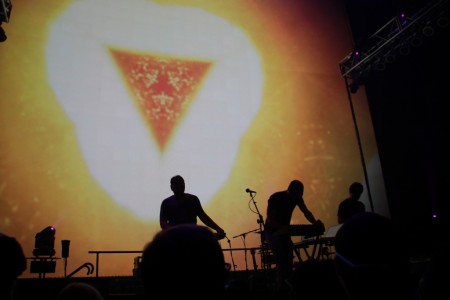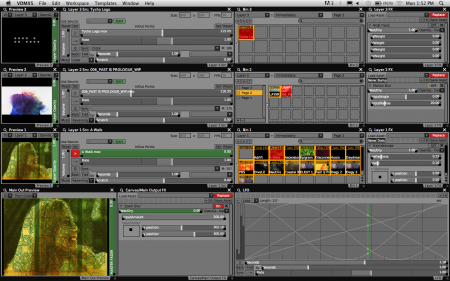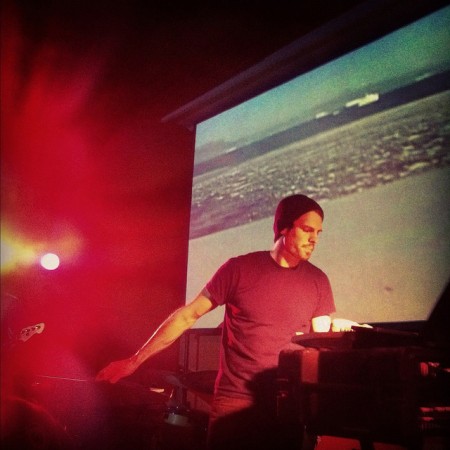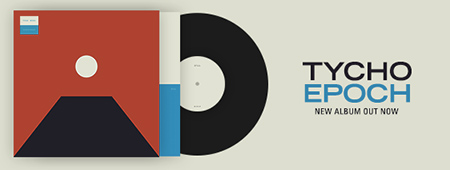VDMX 5

Visuals are a big part of the Tycho live show and I’m often asked how they were created and presented in a live setting. The answer is VDMX, a modular video performance platform. For those of you familiar with video editing / effecting, you could think of it as a stripped down, real-time version of After Effects where every parameter is controllable via various protocols (MIDI, OSC) and even by other parameters. It can mix multiple sources using blending modes like multiply and color burn all while utilizing Quartz Composer effects.

I’ve been using VDMX for a few years now and it’s become one of those tools that I can’t live without. Because it’s modular, VDMX’s interface can be arranged in any way you prefer. I personally use three video decks with and effects bin on each and then a master effects bin. I trigger clips and modulate parameter via MIDI over IP from Reaper running on a Macbook Pro w/ a Vertex 3 MAX IOPS drive (VDMX eats data bandwidth alive!).
VDMX is an incredibly deep and flexible application which I have yet to see any real limitation to. The workflow and functionality is so abstract that there are myriad ways to accomplish pretty much anything you can think of. And therein lies the only real problem I can find with VDMX; the flexibility and modularity afforded by the abstract way in which the application functions comes at the expense of usability. The learning curve is very steep and many of the initial concepts are a little tough to wrap your head around. Vidvox (the developers of VDMX) have put together some great tutorial videos which can help move the learning process along.
Thankfully a new version is out, and with it come some very helpful additions and changes. VDMX 5 is an entirely new program, written from the ground up. For those coming from older versions a lot of the way VDMX works will feel familiar. But you’ll quickly notice that some subtle changes in workflow make a big difference. I just started learning the new version during this current tour and it was pretty straight forward.

VDMX, while certainly not geared toward the casual user, is one of those apps that will allow you to grow into it. The relatively steep learning curve will pay off pretty quickly when you realize just what it’s capable of.
You can grab a demo and get more info here.
Photos by Buweneke and KimJackie

10 Comments Leave A Comment
53T says:
January 30, 2012 at 11:34 amI remember your post about using Reaper in studio… are you using it for your live performances as well? (I couldn’t quite see what you were up to when you you played the Echoplex back in dec).
Ches says:
January 30, 2012 at 11:52 amI know there are always like 100 of these please-come-to-my-town comments on every Tycho related post, but I and probably many others would love to see this setup and music in Vancouver :).
boo says:
January 30, 2012 at 1:58 pmWhoa Scott I’m pretty pumped that you used the instagram I took from your Pittsburgh show (http://instagr.am/p/iwiZS/), Thanks!
Could I get a link back to it, or @spcycuttlefish under it?
Michele Jennings says:
January 30, 2012 at 4:23 pmIt just looks so awesome… I’m sure it’s still just a tool like any other, but the results of some great people working it are definitely great. It is a seriously powerful, versatile tool though.
Rob McDougall says:
January 30, 2012 at 4:40 pmI wrote my dissertation on VDMX 5b7 and really enjoyed. Glad I took the time to learn it when I was a student, nowadays I think I would find it a bit daunting… There’s a PDF on my site here: http://robmac.net/portfolio/audio-reactive-visuals/
Scott says:
January 30, 2012 at 6:17 pm@Boo-
Sorry! Meant to add the credit line but spaced out… fixed.
@53T-
Yeah, using Reaper live for audio. Never felt super confident with Ableton and the few things I lost moving over I’ve made up for with VSTs.
Jason says:
January 30, 2012 at 8:25 pmWould love for you to post some footage of this!
Astrid Salas says:
February 1, 2012 at 3:22 amThis could be very useful for video art installations and even performance for sure. Thank u!
Alex says:
February 1, 2012 at 11:46 amGreetings from the southern tip of africa!!
Really love your work and the overall iso50 movement :)
since you’re unlikely to come down here and brave the wild lions, i’m sure i’m not the only one who’d appreciate a link to anywhere we can see some snippets / songs / pieces of your show online?
Love the album and your graphic work so would be amazing to see the whole tycho experience – admittedly without the base and screaming groupies – but at least get a taste :)
Andy Roush says:
June 27, 2012 at 2:34 pmMissed this post by a mile Scott- you might not even see this reply/question at this point but meant to ask you last we spoke.
Is VDMX capable of any of the dimensional projection that Modul8 can do?
(I use Modul8 and love it)- and your coloration techniques are what really stand out for me with this application of VDMX- it looks perfect and the timing seems all pre-set which is awesome.
Honestly feel like your use of VDMX is the only non-chaotic approach I’ve seen and it makes me want to consider trying it out soon.
Most guys I’ve seen using it just have too much going on and their screens (buried in modules) look more equipped to launch space shuttles than run real-time video sets.
And I assume that since it’s so resource-intensive that explains why those sets always seem really stuttery too- super distracting when it’s like that.
Too long a comment here but thanks for the insight on this.
See you back at Lincoln Hall in a week or so!